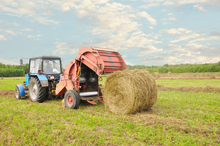US hay stocks are dwindling and worries are rising over grain prices according to Chicago Mercantile Exchange.

Importance of a good 2013 hay crop
US hay supplies remain precariously low and this has negative implications for horse owners as well as beef and dairy producers going into the spring.
US hay supplies remain precariously low and this has negative implications for horse owners as well as beef and dairy producers going into the spring. The shortage of hay supplies further underscores the importance of receiving adequate moisture this winter. The margin for error is close to zero.
The USDA Crop Production report issued in early January pegged total US hay production for 2012 at just 119.9 million tons, about 9% below year ago levels and 16% lower than the five year average. Hay supplies differ dramatically by region.
Hay production in the Great Plains declined by 29% in 2012 (crop year for hay is May - Apr) for the year and it was 31% lower than the five year average. December 1 stocks in some states were down as much as 49% from last year. Hay production in Texas and Oklahoma was double what it was the previous year (a very dismal comparison) but still about 6% less than the five year average. The increase in output helped boost stocks in Texas, a state that accounts for 15% of all US beef cows.
But again, we are comparing to 2011 levels, which was a historic drought years for Texas and surrounding areas. December hay stocks in Texas still were 29% below the five year average. High grain prices has reduced the number of acres that go into hay production.
Last year, US producers harvested 56.3 million hay acres, 7.7 million acres less than in 2002. There are fewer cows today than 10 years ago so not as many hay acres are needed. On the other hand, with grain prices at record highs, it is more important than ever for producers to put weight on animals before they go into feedlots. The drought of 2011 and 2012 has dramatically reduced hay yields.
In 2012, yields for all hay were pegged at 2.13 ton/acre. Note that this is for all kinds of hay across all states. Alfalfa yield for the year was about 3 ton/acre, down 11.5%. One has to go back to the drought of 1988 to find yields lower than those we had in 2012.
The short supplies have caused hay prices to escalate further and prices will be high at least until spring. USDA pegged alfalfa average national prices in December at 217/ton, 9% higher than the record levels of a year ago and a whopping 50% higher than the five year average.
